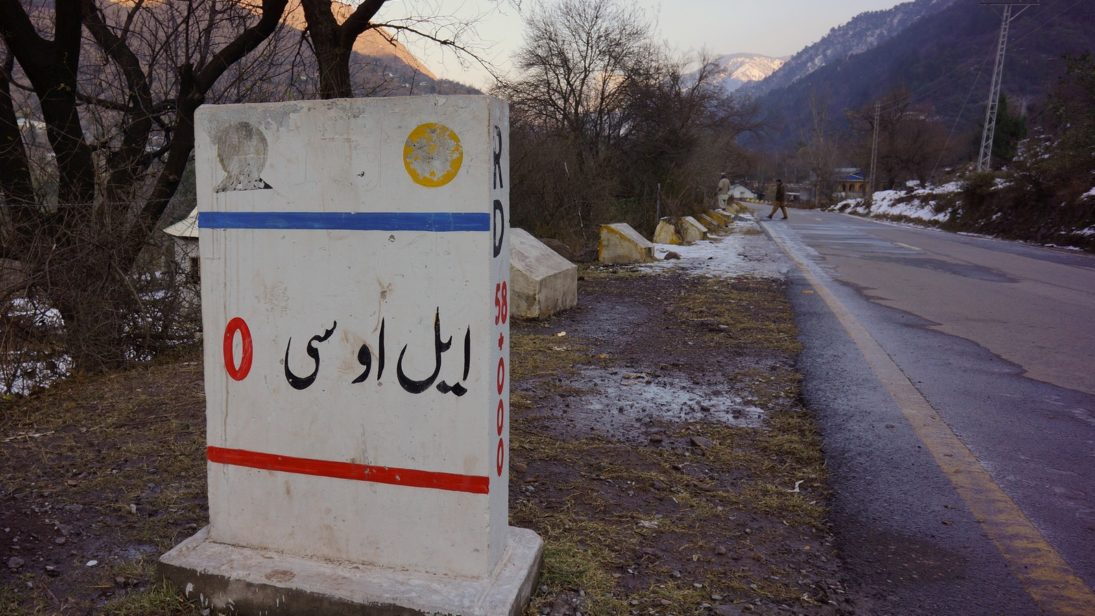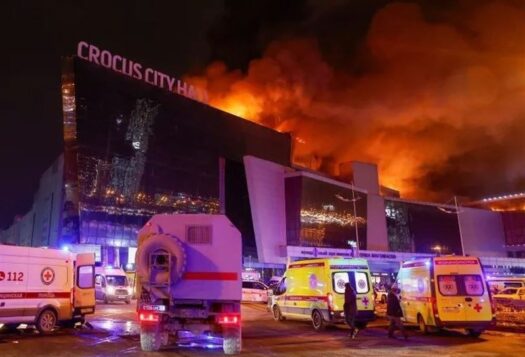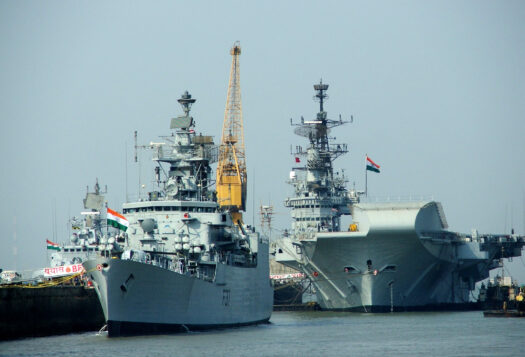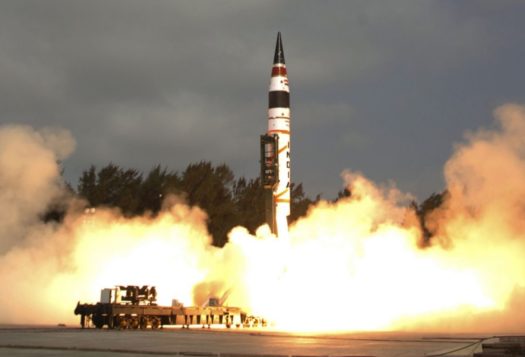
In this new series, SAV talks to scholars and practitioners to understand the trends and potential inflection points in South Asian security.
In an interview with SAV editors Akriti Vasudeva and Emily Tallo in New Delhi, Dr. Happymon Jacob, an Associate Professor at the School of International Studies at Jawaharlal Nehru University, discussed India-Pakistan relations, ceasefire violations on the Line of Control, and the utility of Track-II dialogues. Dr. Jacob hosts a video series called National Security Conversations with The Wire and curates an online archive on India-Pakistan relations at the Indo-Pak Conflict Monitor website. His book, entitled The Line of Control: Traveling with the Indian and Pakistani Armies, will be published by Penguin Random House in November 2018. His second book, Line on Fire: Ceasefire Violations and India-Pakistan Escalation Dynamics, will be published by Oxford University Press in January 2019.
On India-Pakistan Relations:
How do you evaluate the possibility of a thaw in India-Pakistan relations as we approach India’s general elections in mid 2019?
We have a situation between the two sides, wherein one side has completed its national elections and has a government, while the other side will soon go into elections. Until then, clearly it would be premature to consider the possibility of a thaw between the two sides. There have been, as a recent New York Times article points out, some overtures to India from Pakistan through various channels. Prime Minister Khan himself talked about it in his speech soon after his election victory. In fact, General Bajwa himself, in his so-called “Bajwa Doctrine,” did indicate the importance of peace for prosperity, not just for India but for Pakistan domestically.
There have been all kinds of positive signals coming from Pakistan, though the Indians would say that there is the issue of Kashmir that is thrown in. But I wouldn’t blame the Pakistanis for that, precisely because Kashmir has been a major bone of contention between the two sides and any Pakistani leader will have to mention Kashmir. Be that as it may, I don’t see any possibility [for a thaw] whatsoever until the elections are over and we have a new government in place. Based on the shape and form and color of that government, the next step towards Pakistan will be determined and formed.
Foreign policy success with Pakistan won’t get Modi any votes, but foreign policy failure with Pakistan will cost him votes.
The Indian government’s refusal to have a meeting between the two foreign ministers on the sidelines of the United Nations General Assembly meeting in New York should be seen in this context. Imran Khan, fresh with a strong mandate, wants a dialogue, but Narendra Modi, seeking a fresh mandate in India, does not want to take any risks. Foreign policy success with Pakistan won’t get Modi any votes, but foreign policy failure with Pakistan will cost him votes.
How would you assess the problem of a “system mismatch” between India and Pakistan that a recent New York Times report identified? Does the fact that the military is dominant within Pakistan while India has the supremacy of the civilian sector serve as an obstacle to talks?
A lot of people make the argument in India and in other parts of the world that Prime Minister Imran Khan is propped up by the Pakistani military and therefore he’s going to be a puppet in the hands of the Pakistan military. There is therefore absolutely no point, they say, in talking to a puppet. It’s going to be déjà vu.
I look at it very differently. I would say that given the fact that there is a certain elite consensus in Pakistan today between the Pakistan Army and the political establishment, the Indian side, when they try to engage with the Pakistanis, should realize that they are probably talking to the powers that matter there. If you’re talking to Islamabad, Rawalpindi is not going to obstruct that, simply because there is a consensus between Rawalpindi and Islamabad. And, ultimately, if New Delhi wants to send a message to Rawalpindi, that is not going to get lost in Islamabad, during transit. So, I think the system mismatch is technically accurate, but that doesn’t really mean anything at the end of day, simply because elite consensus in Pakistan is good for India when negotiating with Pakistan.
In general, when you talk about the India-Pakistan relationship, many people argue that because of the long history of problems in the relationship, it’s better to have an incremental base of cooperation from which to inch the relationship forward. This can then be built upon to talk about contentious issues. So, what are some small steps that can be taken?
It is interesting to note that despite all the ceasefire violations and the terror attacks and the war of words between the two sides, the local trade on the Line of Control did continue mostly undisturbed. The short-term visas, travel permits given to people on either side of the divide in Jammu and Kashmir also continued. So, I think the two sides should try to enhance the trade and travel, the confidence-building measures on the Line of Control between the two sides, and then start from there. Then, once the next government is in place in New Delhi, they should consider talking about trade, and then move on to less contentious items. Then go for the big-bang issue, which is the Kashmir conflict.

On ceasefire violations:
In your 2017 report for the U.S. Institute of Peace (USIP) on the motivations for ceasefire violations on the Line of Control in Jammu and Kashmir, you write that “ceasefire violations are generally not planned, directed, or cleared by higher military commands or political establishments, but are driven by the dynamics on the frontlines.” With this, you are referring to the local-level military factors that at times cause crossborder firing. How did you reach this conclusion?
Traditionally, there has been an argument in India that ceasefire violations take place because the Pakistani side infiltrates terrorists into Jammu and Kashmir and in order to aid and abet the intruding terrorists in Jammu and Kashmir, the Pakistani Army gives covering fire, to which the Indian side responds. As part of my USIP report and my upcoming book project, I interviewed about 80 to 85 officers from the Indian and Pakistani side, serving and retired military officers, at least 30 of whom are Pakistani military officers. I also traveled along the Line of Control along both sides of the border hosted by the Indian Army and the Pakistan Army in the last two years, and I’ve traveled with the Border Security Force (BSF) on the Indian side.
There is no Line of Control; it’s a notion that there is a Line of Control. It’s not demarcated on the ground. People cross back and forth, and Pakistani villagers live up to the zero line, while Indian villagers do not. Sometimes even soldiers on both sides tend to lose track of where they are and go into each other’s territory, and this kind of thing tends to cause ceasefire violations. There are a host of local factors, including the capture of small pieces of territory as well as defense construction on the Line of Control.
Another reason why terrorist infiltration is probably not the most important cause of ceasefire violations: most of the terrorist infiltration takes place north of the Pir Panjal range, whereas the ceasefire violations take place south of the Pir Panjal, so there is the geographical mismatch right there. Secondly, if the Pakistani side wants to aid and abet the intrusion of terrorists into the Indian side, why would they fire and warn the Indian side?
In the same report, you argue that ceasefire violations can both precipitate and worsen crises in India-Pakistan relations. In concrete terms, what are the dangers of this escalation—how can low-level firing across the LoC get out of hand?
As part of my book project, I looked at India-Pakistan escalation data, diplomatic, military, and political escalation data from 2002-2017. I also looked at the ceasefire violation data from 2002-2017, and I compared the two. From there, I could find at least 9-10 cases where ceasefire violations, in the absence of any other provocation, have led to serious escalation between India and Pakistan—diplomatic, military, and political. So, I have data to suggest that ceasefire violations, independent of other triggers, lead to escalation between the two sides.
You can’t man a border of 1,125 kilometers that is infested with all kinds of complications with a telephone conversation. You need to have do’s, don’ts, principles, norms, regulations put down in black and white.
When ceasefire violations take place simultaneously with terrorist attacks, which can happen, or sequentially with terrorist attacks the escalatory potential of ceasefire violations increases. Put differently, if you have a ceasefire violation, and then soon after you have a terrorist attack, or you have a terrorist attack and then you have ceasefire violations, this worsens the escalation dynamics between India and Pakistan. More importantly, with the coming of 24/7 media in India and Pakistan, what happens on the Line of Control does not really stay on the Line of Control—it becomes a major news item for TV channels. It gets flashed around, and people talk about it, and politicians and the military come under a huge amount of public pressure to retaliate, who, aware of the audience costs, in turn engage in unhelpful rhetoric.
It’s important to remember that we do not have any written down ceasefire agreement. All we have at this point of time is a telephone conversation between the Director Generals of Military Operations of India and Pakistan in 2003. You can’t man a border of 1,125 kilometers that is infested with all kinds of complications with a telephone conversation. You need to have do’s, don’ts, principles, norms, regulations put down in black and white.
On Track-II diplomacy:
You have been involved in various India-Pakistan Track-II dialogues, including the Chaophraya Dialogue, Pugwash India-Pakistan Dialogue, and the Ottawa Dialogue on India-Pakistan Nuclear Relation, which bring together Indian and Pakistani experts and former government and military officials to identify new areas of cooperation and rethink old assumptions. In your opinion, what is the utility of Track-II dialogues, and how can they move the ledger forward on improving India-Pakistan relations?
The Chaophraya dialogue began in 2009 after the Mumbai attacks in 2008, when the governments were not talking to each other. There was a complete breakdown of bilateral relations. We started this project with the help of the British High Commission in Delhi to bring together Indian and Pakistani interlocutors; because if the governments are not talking, somebody needed to talk. In almost ten years, we have met over 25 times and managed to bring together politicians, officials, military officers, civil society actors, journalists, among others. They come to these meetings held under Chatham House rules, talk, discuss specific issues, try to gauge the temperature on the other side, become cognizant of the red lines the other side has, and then they go back to their capitals and communicate what was conveyed by the other side to various stakeholders. With the kind of media bashing of each other that is going on today, it is important for influential individuals to go to some of these forums to understand what really is happening and determine the best way forward.
If you ask me, “Show me the impact of Track-II meeting on the ground in policy change,” I would say, “That’s not how we operate.” I think we contribute to the knowledge community, and that epistemic community in a country like India, which is a democracy, is very important.
The other thing that these forums do is to keep some suggestions for conflict resolution ready for the governments to pick up and implement as and when the time is right. For example, the kind of work that we are doing on the Line of Control, or the kind of discussions on potential for India-Pakistan trade could eventually be useful for the two governments. I’m a firm believer that governments are not the depository of all wisdom. Governments look out for solutions. At these Track-IIs, people prepare solutions based on objective evidence and after gauging the mood on the other side, these are then communicated back to the governments, so their respective departments and desks can make use of this asset when the time is right.
So, if you ask me, “Show me the impact of Track-II meeting on the ground in policy change,” I would say, “That’s not how we operate.” I think we can contribute to the ecosystem. I think we contribute to the knowledge community, and that epistemic community in a country like India, which is a democracy, is very important. All that eventually leads up to policymaking.
On the Kashmir conflict:
The security situation in Kashmir remains tense. After the dissolution of the BJP-PDP coalition government and Panchayat, State Assembly, and Lok Sabha elections scheduled for next year, how do you see the state-wide political situation in Kashmir impacting the security situation? Are elections possible under these conditions?
I’m skeptical about the political environment in Jammu and Kashmir. There was a lot of pessimism and negativity among the Kashmiris about the Bharatiya Janata Party (BJP)-People’s Democratic Party (PDP) coalition government. The collapse of that coalition government was received well by a lot of people in Kashmir. I spent some time in Kashmir recently, and the feeling that I get is that there is a rising level of alienation in Kashmir. And there is an unnecessary politicization and secularization of the Kashmir conflict by the BJP for electoral purposes in India.
Infiltration has not gone down. If anything, infiltration has only gone up. Educated boys are taking up guns and joining the ranks of the militancy. There is popular legitimacy for these kids, among families, among parents, among the population at large, that is worrisome. From 2008 to 2010, we did see some recruitments, but the legitimacy for that was not all that rampant. People would say, “These are misguided youth. They shouldn’t do this. This is against Islam.” Today, there is a feeling of “What option do they have? What choice do they have?” Some parents justify their kids taking up guns by saying, “He is doing the work of God. That is Jihad, and that’s what he should be doing.” In this context, the holding of local body elections is going to be a challenge. Clearly, the 2019 elections will take place, but I don’t think this is a favorable environment for them.
***
Click here to read this article in Urdu.
Image 1: Usman Malik via Flickr
Image 2: Chris Hondros via Getty


